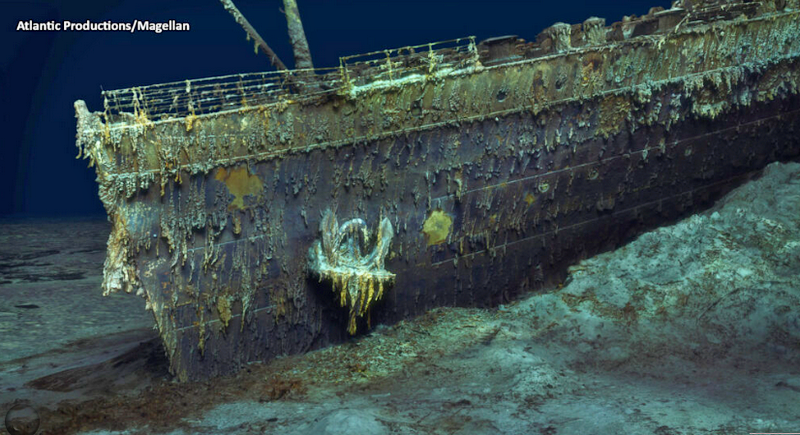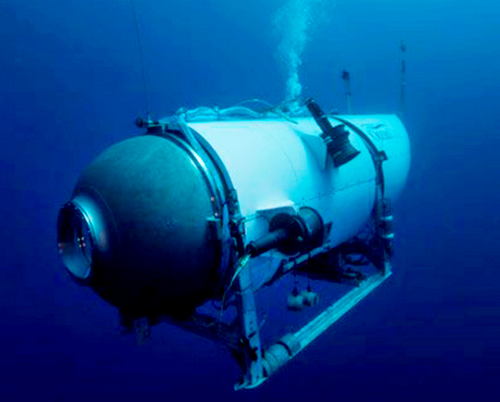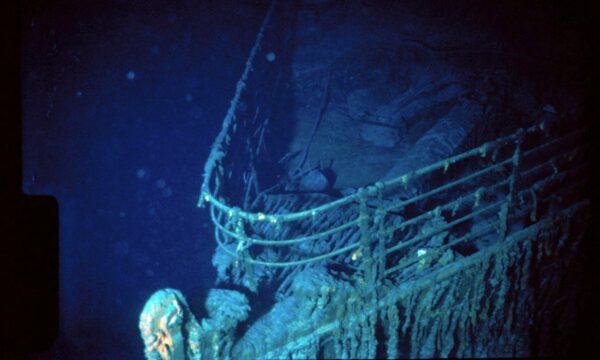US Coast Guard confirms crew of Titan sub has died after 'catastrophic' event

By Guardian - 22 June 2023 20.02 BST
Maya Yang (now); Léonie Chao-Fong, Fran Lawther, Sam Jones, and Royce Kurmelovs
Rear Adm John Mauger, the First Coast Guard District commander says a remotely operated vehicle from Horizon Arctic discovered the tail cone of the Titan sub approximately 1,600 feet from the bow of the Titanic on the seafloor.
The debris is “consistent with a catastrophic loss of the pressure chamber”, he says.
Upon this determination, we immediately notified the families on behalf of the United States Coast Guard and the entire unified command. I offer my deepest condolences to the families.
- Updated at 20.09 BST

Titan is constructed, per OceanGate's website, with a combination of carbon fiber and titanium, a departure from the more common use of titanium alone. According to an OceanGate blog post, Titan is not classified according to industry standards — a decision taken in favor of "innovation," the company said.
Titanic director James Cameron: "I'm struck by the similarity" of both incidents
Titanic film director James Cameron who has made 33 dives to the wreck site has responded to the news of OceanGate Titan’s submersible imploding.
In an interview with ABC, Cameron said:
“I’ve been down there many times… I know the wreck site very well… I understand the engineering problems associated with building this type of vehicle and all the safety protocols…
This is a mature art and many people in the community were concerned about the sub… I’m struck by the similarity of the Titanic disaster itself, where the captain was repeatedly warned about ice ahead of his ship and yet he steamed at full speed into an ice field on a moonless night and many people died as a result.”
Summary of the day so far
- Five crew members aboard the submersible Titan were probably killed instantly in a “catastrophic implosion” as it descended to the wreck of the Titanic two miles below the surface of the Atlantic Ocean, US Coast Guard officials said.
- A large debris field containing five major pieces of the vessel was spotted by a remotely operated vehicle (ROV) scouring the seabed near the Titanic wreck site 400 miles south of St John’s, Newfoundland, officials said. The debris was “consistent with the catastrophic loss of the pressure chamber”, they said.
- It is too early to tell exactly when the implosion occurred, officials said, noting that nothing was detected on sonar buoys deployed in the ocean in recent days.
- Those aboard the submersible were British adventurer Hamish Harding, 58; French veteran Titanic explorer Paul Henri Nargeoloet, 77; British-Pakistani businessman Shahzada Dawood, 48, and his 19-year-old son Suleman; and 61-year-old American Stockton Rush, co-founder of OceanGate, the company that operated the lost sub.
- Officials could not confirm whether they will be able to recover the bodies of the crew members. The US Coast Guard will continue to investigate the site of the debris field, while vessels and personnel will be demobilized over the next 24 hours.
We have the latest info here at a glance: Titan sub implosion: what we know at a glance
Read more
- Updated at 21.08 BST
- 39m ago20.51 BST
Richard Garriott, president of the Explorers Club, of which Hamish Harding and Paul-Henri Nargeolet were both members, has said he is “heartbroken for the families, friends, and colleagues of those who were lost”.
The statement reads:
Our friends and fellow Explorers Club members Hamish Harding and Paul-Henri Nargeolet are lost, along with Stockton Rush, Shahzada Dawood and his son Suleman, while trying to reach the RMS Titanic.
He said the club is “grateful for all our members and the scientific and exploration community around the world who have mobilized personnel and resources to support the search and rescue”.

Garriott described Harding as a “dear friend” to himself and the Explorers Club. “He holds several world records and has continued to push dragons off maps both in person and through supporting expeditions and worthy causes,” he says.
Harding and Nargeolet were “both drawn to explore…in the name of meaningful science for the betterment of mankind”, he added.
We’re heartbroken for the families, friends and colleagues of those who were lost. Their memories will be a blessing and will continue to inspire us in the name of science and exploration.
- Updated at 20.51 BST
Support the Guardian
Fiercely independent journalism shapes a fairer world. At the Guardian, we have no billionaire owner, so we’re free to report rigorously on world events, never manipulated or silenced by outside influence.
This live blog is no different and is a great way to understand every single minute of a story as it unfolds. We’ve been publishing our live blogs for more than two decades – covering huge political moments, conflict and war, natural disasters, sports matches and so much more.
And they have been read by millions because we keep Guardian journalism open and free for everyone. We all deserve to read trustworthy information to better understand our world’s people, power, and politics.
46m ago20.44 BST
The UK’s foreign secretary, James Cleverly, has paid tribute to the five crew members – including three British citizens – who died on board the Titan sub.
He posted to Twitter:
Tragic news that those on the Titan submersible, including three British citizens, have been lost following an international search operation.
The UK government is closely supporting the families affected and expresses our deepest condolences.
Tragic news that those on the Titan submersible, including three British citizens, have been lost following an international search operation.
— James Cleverly🇬🇧 (@JamesCleverly) June 22, 2023
The UK government is closely supporting the families affected and expresses our deepest condolences.
- 54m ago20.36 BST
Vessels and personnel to be demobilized over next 24 hours, says US Coast Guard
US Coast Guard officials said the next phase would be to make sure that the families of those crew members on board the Titan sub “have an understanding as fast as we can of what happened and begin to find some closure”.
Teams will continue to investigate the site of the debris field, officials said.
Rear Adm Mauger said there were nine vessels on the scene as well as medical personnel and other technicians.
We will begin to demobilise personnel and vessels from the scene over the course of the next 24 hours. But we’re going to continue remote operations on the sea floor.
He said he did not have a timeline for when the remote operations on the seafloor would be stopped.
- Updated at 20.38 BST
- 1h ago20.30 BST
It is too early to know when the “catastrophic implosion” took place, Rear Adm Mauger says.
We know that as we’ve been prosecuting this search over the course of the last 72 hours.
Beyond that, we’ve had sonar buoys in the water nearly continuously and have not detected any catastrophic events when those buoys have been in the water.
- 1h ago20.27 BST
Size of the debris field consistent with implosion, says expert
Asked if the sub could have collided with the Titanic, Carl Hartsville of the Woods Hole Oceanographic Institution says the wreck lies approximately 1,600 feet from the Titanic.
That area does not have any debris from the Titanic, he says.
It is a smooth bottom there. To my knowledge and anything I’ve seen there’s no Titanic wreckage in that area.
The debris found off the Titan sub lies “200 plus meters” from the bow of the Titanic wreck, he says.
It’s consistent with the location of last communication for an implosion in the water column. The size of the debris field is consistent with that implosion in the water column.
- Updated at 20.39 BST
- 1h ago20.17 BST
R Adm John Mauger says the 'catastrophic implosion of the vessel would have been picked up by sonar
Rear Adm John Mauger says there “doesn’t appear to be any connection” between the underwater noises detected in the search-and-rescue mission and the location on the seafloor.
This was a “catastrophic implosion” of the vessel which would have “generated a significant… sound down there that the sonar buoys would have picked up”, he says.
- Updated at 20.22 BST
- 1h ago20.14 BST
Asked what the prospects are for recovering the bodies of the crew members, Rear Adm John Mauger replies:
We’ll continue to work and continue to search the area, but I don’t have an answer for prospects at this time.
This is an “incredibly unforgiving environment”, he adds.
- Updated at 20.18 BST
- 1h ago20.11 BST
Five different pieces of debris signaled it was Titan sub, says expert
Paul Hankin, an undersea expert, says rescuers found “five different major pieces of debris that told us that it was the remains of the Titan”.
The initial thing we found was the nose cone... then we found a large debris field. Within that large debris field, we found the front end bell of the pressure hull. That was the first indication that there was a catastrophic event.
Shortly after, we found a second smaller debris field within that debris field. We found the other end of the press hull that…basically comprised of the totality of that pressure chamber...
We will do our best to fully map out what’s down there.
- Updated at 20.41 BST
- 1h ago20.09 BST
Rear Adm John Mauger says it is an “incredibly complex” case and that the team is still working to develop the details for the timeline.
The ROVs are operating in a complex environment on the seafloor over two miles beneath the surface, he says.
Rear Adm John Mauger says he hopes that this discovery provides some solace to the families of the crew on board the Titan sub during this difficult time.
He says the team has been in close contact with the British and French consuls general to ensure that they are fully apprised.
The US Coast Guard is “grateful for the rapid mobilization of experts on the undersea search and rescue” and “incredibly grateful for this full spectrum of international assistance that’s been provided”.
The ROVs will remain on scene and continue to gather information, he says.
- 1h ago20.02 BST
US Coast Guard confirms crew of Titan sub has died after 'catastrophic' event
Rear Adm John Mauger, the First Coast Guard District commander says a remotely operated vehicle from Horizon Arctic discovered the tail cone of the Titan sub approximately 1,600 feet from the bow of the Titanic on the seafloor.
The debris is “consistent with a catastrophic loss of the pressure chamber”, he says.
Upon this determination, we immediately notified the families on behalf of the United States Coast Guard and the entire unified command. I offer my deepest condolences to the families.
- Updated at 20.09 BST
- 2h ago19.51 BST
Here’s the full statement by OceanGate, as reported by the BBC:
We now believe that our CEO Stockton Rush, Shahzada Dawood and his son Suleman Dawood, Hamish Harding, and Paul-Henri Nargeolet, have sadly been lost.
These men were true explorers who shared a distinct spirit of adventure, and a deep passion for exploring and protecting the world’s oceans. Our hearts are with these five souls and every member of their families during this tragic time. We grieve the loss of life and joy they brought to everyone they knew.
This is an extremely sad time for our dedicated employees who are exhausted and grieving deeply over this loss. The entire OceanGate family is deeply grateful for the countless men and women from multiple organizations of the international community who expedited wide-ranging resources and have worked so very hard on this mission.
We appreciate their commitment to finding these five explorers, and their days and nights of tireless work in support of our crew and their families.
This is a very sad time for the entire explorer community, and for each of the family members of those lost at sea.
We respectfully ask that the privacy of these families be respected during this most painful time.
TITANIC SUBMERSIBLE IMPLOSION
By The Epoch Times - News from the US Navy 23 June 2023
Sensitive US Navy Equipment Detected Missing Sub’s Implosion on Sunday
The U.S. Navy detected the Titanic-bound submersible’s implosion on Sunday, days before the information was disclosed to the public on Thursday after a massive search operation that captured global attention, according to a U.S. Coast Guard (USCG) official.
The five men aboard the Titan, who were attempting to explore the Titanic wreckage in the Atlantic Ocean, are believed to have tragically perished due to a suspected “catastrophic implosion,” according to USCG officials.
In a surprising revelation, the USCG has confirmed that the U.S. Navy first detected the implosion soon after the Titan went missing on Sunday. The Navy promptly provided this information to aid the search and rescue efforts, although its significance could not be definitively determined. The Wall Street Journal first reported the news citing unnamed sources.
“As a member of the Unified Command, the U.S. Navy conducted an analysis of acoustic data and detected an anomaly consistent with an implosion or explosion in the general vicinity of where the Titan submersible was operating when communications were lost,” USCG spokesperson Petty Officer 3rd Class Briana Carter said in a statement.
“While not definitive, this information was immediately shared with the Incident Commander to assist with the search and rescue mission.”
During a press briefing held at 3 p.m. on Thursday, Coast Guard Rear Adm. John W. Mauger revealed that a debris field, presumably belonging to the missing vessel, was discovered approximately 1,600 feet from the bow of the Titanic wreckage. He noted that this debris field indicated a “catastrophic implosion” and appeared to be “consistent with catastrophic loss of the pressure chamber” within the submersible.
Mauger expressed his condolences to the families affected by this tragic event.
“Upon this determination, we immediately notified the families,” he said. “On behalf of the United States Coast Guard and the entire unified command, I offer my deepest condolences to the families. I can only imagine what this has been like for them. And I hope that this discovery provides some solace during this difficult time.”
Race Against Time
Initially, it was estimated that the five individuals on board had approximately 96 hours’ worth of oxygen supply from the time the vessel first submerged on Sunday morning. However, considering the possibility of oxygen conservation, it remains unclear how long they may have survived.
OceanGate, the operator of the submersible vehicle, expressed profound grief in a statement released on Thursday. The company confirmed the loss of its CEO Stockton Rush, along with Shahzada Dawood, Suleman Dawood, Hamish Harding, and Paul-Henri Nargeolet, acknowledging their adventurous spirits and deep passion for exploring and preserving the world’s oceans.
“These men were true explorers who shared a distinct spirit of adventure, and a deep passion for exploring and protecting the world’s oceans,” the statement reads. “Our hearts are with these five souls and every member of their families during this tragic time.”

OceanGate expressed gratitude for the efforts of those involved in the days-long search that involved multiple organizations and countries “who expedited wide-ranging resources and have worked so very hard on this mission.” The company stated its appreciation for “their commitment to finding these five explorers, and their days and nights of tireless work in support of our crew and their families.”
“This is a very sad time for the entire explorer community, and for each of the family members of those lost at sea,” the statement reads. “We respectfully ask that the privacy of these families be respected during this most painful time.”
Rescue efforts involved a concerted mobilization of ships, planes, and sophisticated equipment, although the operation faced challenges due to changing weather conditions, ocean currents, and sea states.
A breakthrough came on Wednesday when the U.S. Coast Guard announced the successful deployment of an undersea robot by a Canadian vessel, which effectively reached the ocean floor. Additionally, a French research institute stated that a deep-diving robot with cameras, lights, and arms also joined the operation.
Authorities had been hoping that underwater sounds might help narrow their search, with a coverage area that has been expanded to thousands of miles—twice the size of Connecticut—and in waters 2.5 miles deep. Coast Guard officials said underwater noises were detected in the search area on Tuesday and Wednesday.
Jack Phillips contributed to this report
